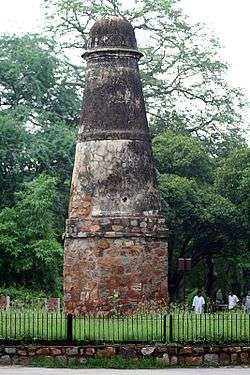Kos (unit)
| Kos (unit) | |
|---|---|
| Unit system | Arthashastra |
| Unit of | length |
| Symbol | kos |
| Unit conversions | |
| 1 kos in ... | ... is equal to ... |
| SI units | 3075 m |
| imperial/US units |
1.91 mi 10088 ft |
The kos (Sanskrit: कोस), also spelled Kosh, Krosh, krosha and Koss, is an ancient Indian subcontinental Arthashastra standard unit of distance, since at least 4 BCE.[1] A kos is about 3.00 km or 1.91 miles.
Arthashastra Standard units

The "Arthashastra: Chapter XX. Measurement of space and time", authored in 4th century BCE by Chanakya (Vishnugupta Kauṭilya), sets this standard breakup of Indian units of length:[1][2]
- 1 Angul (approximate width of a finger) = approx. 3/4 of an inch;
- 4 Angul = Dhanurgrah (bow grip) = 3 in;
- 8 Angul = 1 Dhanurmushti (fist with thumb raised) = 6 in;
- 12 Angul = 1 Vitastaa (span-distance of stretched out palm between the tips of a person's thumb and the little finger) = 9 in;
- 2 Vitastaa (from the tip of the elbow to the tip of the middle finger) = 1 Aratni or Hast (cubit or Haath) = 18 in;
- 4 Aratni (Haath) = 1 Dand or Dhanush (bow) = 6 ft;
- 10 Dand = 1 Rajju = 60 ft;
- 2 Rajju = 1 Paridesh = 120 ft;
- 2000 Dand (Dhanush) = 1 Krosha (krosh or kos) or Goruta = 4000 yards or 21⁄4 miles - nearly 3.66 km;
- 4 Krosh = 1 Yojan = 9 miles - nearly 15 km;
Conversion to SI units and Imperial units
Kos may also refer to roughly 1.8 km (1⅛ mile) or 3.2 km (2 miles).[3] Arthashastra Standard unit of Kos or krosh is equal to 3075 metres in SI units and 1.91 miles in Imperial units.[4]
Usage of Kos
Evidence of official usage exists from Vedic period to the Mughal era. As of 2017, elderly people in some rural areas of the Indian subcontinent still refer to distances from nearby areas in kos. Most Hindu religious Parikrama circuits are measured in kos, such as 48 kos parikrama of Kurukshetra. Along India's old highways, particularly the Grand Trunk Road, one still finds 16th to early 18th century Kos Minars, or mile markers, erected at distances of a little over two miles[5]
See also
References
- 1 2 Arthashastra, Chanakya, 4th century BCE, pp151
- ↑ "Valmiki Ramayana / Book III: Aranya Kanda - The Forest Trek / Chapter (Sarga) 69". Retrieved 2007-09-29.
- ↑ Measure for Measure, Young & Glover, 1996
- ↑ [Cosmic Order and Cultural Astronomy: Sacred Cities of India, By Rana P. B. Singh with a Foreword by John, 2009. pp.4]
- ↑ C.D. Verma (2006-07-10). "Signposts lost in history". Tribune India. Retrieved 2007-09-29.